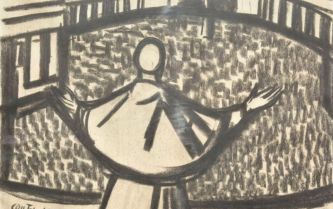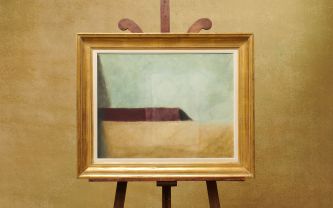Cote et valeur des tableaux russes de Mikhaïl Guermacheff

Si vous détenez une œuvre réalisée par l’artiste Mikhail Guermacheff ou d’après son travail et que vous souhaitez connaître sa valeur, nos experts et commissaires-priseurs agréés par l’État vous aiguilleront.
Nos spécialistes réaliseront une expertise gratuite de votre œuvre, et vous transmettront une estimation précise de sa valeur sur le marché actuel. Par la suite, si vous désirez vendre votre œuvre, nous vous orienterons vers le meilleur dispositif possible pour en obtenir un prix optimal.
Cote et valeur de l’artiste
Le travail de Mikhail Guermacheff est peu courant et assez bien coté sur le marché des enchères. Ses œuvres suscitent un intérêt parmi les collectionneurs et les amateurs d'art, en particulier ceux qui apprécient la peinture russe du XXème siècle.
La cote de ses œuvres est actuellement en hausse sur le marché de l’art, et le prix auquel ses œuvres se vendent sur le marché de l’art s’échelonne entre 200 et 135 000€, pour le moment, un delta considérable mais qui en dit long sur la valeur qui peut être attribuée aux œuvres de l’artiste.
Les pièces les plus recherchées sont les peintures représentant des paysages. Ainsi, une œuvre signée Guermacheff peut atteindre des milliers d’euros aux enchères, comme son tableau Le Kremlin sous la neige, adjugé pour 135 000€ en 2008, tandis qu’il était estimé entre 40 000 et 50 000€.
Ordre de valeur allant du plus basique au plus prestigieux
Technique utilisée | Résultat |
|---|---|
Dessin - aquarelle | De 200 à 360€ |
Peintures | De 200 à 135 000€ |
Réponse en - de 24h
Style et technique de Mikhail Guermacheff
Mikhail Guermacheff fait partie du groupe de l’École de Paris, comme d’autres artistes (Michel Kikoine, Alessio Isupoff, Nicolas de Staël) ayant immigré de la Russie à Paris, même si ce terme est beaucoup trop large pour donner une définition précise de son travail.
Il s’intègre parmi les artistes réalistes russes, et produit surtout des huiles sur toile. Guermacheff effectue un grand travail sur la représentation de la lumière, en s’inspirant en particulier de paysages enneigés.
La vie de Mikhail Guermacheff
Mikhail Markanovich Guermacheff (1867-1930) est un peintre russe associé à l’École de Paris. Né à Kharkov, dans l’Empire russe, il reçoit sa formation artistique à l’École des Beaux-Arts de Moscou, où il se spécialise dans la peinture de paysage et maîtrise les techniques des réalistes russes.
Il participe à divers Salons, notamment à Moscou et Saint-Pétersbourg, où il expose ses œuvres.
Après la révolution de 1917, Guermacheff, comme nombre de ses contemporains, doit quitter son pays natal. Il s’installe en France, où il présente ses toiles au Grand Palais des Champs-Élysées et au Salon de la Société nationale des Beaux-Arts.
Ses œuvres, marquées par le réalisme russe de ses débuts, dépeignent un pays lumineux et idéalisé, contrastant avec les bouleversements révolutionnaires du XXe siècle. Elles expriment une nostalgie discrète pour les derniers instants de l’Empire russe, particulièrement dans ses célèbres représentations du Kremlin enneigé.
Guermacheff s'éteint à Paris en 1930.


Comprendre le réalisme russe en peinture
Le réalisme russe en peinture, mouvement prédominant au XIXe siècle en Russie, se distingue par sa volonté de représenter fidèlement la vie quotidienne, les paysages et les scènes rurales de l'Empire russe, en insistant particulièrement sur le travail de la lumière.
Influencé par les idéaux sociaux et politiques de l’époque, ce courant artistique cherche à refléter la réalité sans embellissement, en capturant la dureté de la vie paysanne et les contrastes frappants entre les différentes classes sociales.
Les artistes réalistes russes, tels que Ilia Répine, Vassili Perov, et Ivan Chichkine, ont joué un rôle essentiel dans l’émergence de ce style, privilégiant une approche narrative et souvent critique dans leurs œuvres.
La peinture réaliste russe se caractérise par une attention méticuleuse aux détails, une palette de couleurs sobres et une lumière naturelle qui confère aux tableaux une atmosphère à la fois tangible et poignante.
En dépeignant les vastes étendues de la campagne russe ou les portraits empreints de dignité des travailleurs et paysans, ces artistes ont immortalisé un monde en mutation, tout en exprimant un attachement profond à leur terre natale, marquant ainsi l’histoire de l’art russe.
Beaucoup d’artistes comme Constantin Korovine et Nikolaï Sapunov ont également réalisé des peintures de paysage sans protagonistes ou portraits. Celles de Korovine, qui a notamment réalisé des Vues de Paris, sont aujourd’hui très cotées sur le marché des enchères.

Focus sur un paysage de Guermacheff (début XXème)
Guermacheff nous invite ici à découvrir une paisible scène hivernale où les éléments se fondent de manière tout à fait harmonieuse. L’artiste ne datait pas ses tableaux, et peu d’informations documentaires sont disponibles sur la plupart de ses paysages, ne permettant pas de donner un titre précis.
Dans cette œuvre, la neige recouvre tout le paysage d’un blanc doux, apportant une sensation de calme et de sérénité. Les teintes subtiles, du bleu du ciel au rouge des toits, apportent une touche de chaleur à ce paysage froid.
Les traces laissées dans la neige nous racontent une histoire discrète, guidant notre regard à travers le tableau. L’artiste laisse deviner le craquement du sol ainsi que la fraîcheur de l’air. Les arbres, avec leurs branches nues, se dressent comme des sentinelles, leurs ombres s'étirant délicatement sur le sol enneigé.
Chaque détail, qu'il s'agisse des maisons en bois ou des ombres, semble pensé pour créer une atmosphère tranquille et équilibrée.
Guermacheff capture ici l’essence d’un moment simple mais beau, où la nature et l’architecture coexistent dans une parfaite harmonie. Le tout dégage une douce mélodie visuelle, où la lumière et la couleur jouent ensemble pour apaiser l’esprit.
Laissant deviner la présence humaine sans pour autant la représenter, cette œuvre est caractéristique des paysages russes produits par l’artiste durant sa carrière, et est au-delà caractéristique des tableaux réalistes russes du début du XXème siècle.
Guermacheff s’inscrit ainsi dans un contexte de création établi par ces prédécesseurs en s’inscrivant dans leur sillage, et signe une œuvre tout à fait marquante réunissant de nombreux éléments propres au réalisme russe.
Comprendre le réalisme russe de Germacheff à travers Répine
Le contexte créatif du réalisme russe au XXème siècle
Au début du XXe siècle, la peinture réaliste russe continue de raconter la vie quotidienne avec une sincérité touchante. Les artistes de cette époque sont profondément ancrés dans la tradition du réalisme, héritée des grands maîtres du siècle précédent.
Ils s’attachent à représenter les scènes de la vie rurale, les paysages vastes et souvent austères de la campagne, ainsi que les conditions de vie des ouvriers et des paysans.
Il ne s’agit pas seulement de dépeindre la réalité, mais de la comprendre et de la partager, avec une attention particulière aux détails qui révèlent la beauté et la dureté de cette existence.
Pourtant, ces artistes ne travaillent pas dans un vide. Leur époque est marquée par des bouleversements sociaux et politiques profonds.
Alors que la Russie se dirige vers la Révolution de 1917, les tensions sociales et les aspirations à un monde meilleur se font sentir de plus en plus intensément. Dans ce climat, le réalisme pictural commence à évoluer.
Les œuvres deviennent progressivement plus engagées, capturant non seulement ce qui est, mais aussi ce qui pourrait être. Les peintres cherchent à exprimer les espoirs, les frustrations et les luttes du peuple russe, dans un moment où l’histoire est sur le point de basculer.
Après la Révolution, l’art en Russie prend une nouvelle direction. Le réalisme ne disparaît pas, mais il est transformé par les exigences du nouvel État soviétique.
Ce qui émerge, c'est le réalisme socialiste, un style où les artistes sont appelés à glorifier le prolétariat, à exalter le travail et à promouvoir les idéaux du régime communiste.
L’art devient alors un outil de propagande, tout en conservant les techniques et l’attention aux détails qui caractérisaient le réalisme d’avant la Révolution.
Ainsi, la peinture réaliste russe du début du XXe siècle témoigne d’une période de transition, où les artistes, tout en restant fidèles à une tradition de représentation fidèle du monde, commencent à saisir les courants de changement qui traversent leur société.
C’est une époque où l’art se fait l’écho d’un monde en mutation, où chaque coup de pinceau raconte à la fois le présent et les espoirs d’un avenir encore incertain.
L’empreinte de Mikhail Guermacheff sur sa période
Mikhail Guermacheff n’est pas un peintre très connu du grand public, de son vivant ou aujourd’hui. Ses peintures représentant des paysages et autres compositions sont cependant appréciées des collectionneurs et ont un certain succès aux enchères.
Certaines de ses œuvres sont exposées dans des musées en France, mais les collectionneurs privés jouent un rôle majeur dans la conservation de son œuvre.
Sa signature
Les œuvres de Mikhail Guermacheff ne sont pas toutes signées. Il est également possible qu’il s’agisse d’une copie ou que la mention se soit effacée avec le temps, c’est la raison pour laquelle l’expertise est primordiale.

Expertiser votre bien
Si vous êtes propriétaire d'une œuvre de Mikhail Guermacheff, n'hésitez pas à solliciter une évaluation gratuite en remplissant notre formulaire en ligne.
Un membre de notre équipe, composée d'experts et de commissaires-priseurs agréés, vous contactera pour vous fournir une estimation de la valeur marchande de votre œuvre.
Si vous envisagez de vendre votre œuvre, nos spécialistes vous guideront également à travers les différentes alternatives disponibles pour obtenir le meilleur prix possible, en tenant compte des tendances du marché et des spécificités de chaque œuvre.
Réponse en - de 24h
A découvrir dans la même thématique

La valeur et cote des tableaux de Jean Couty
Jean Couty a produit des oeuvres d'art contemporain, prisées actuellement sur le marché de l'art. La valeur de ses tableaux est toujours aussi élevée.
En savoir plus >

Cote et valeur des oeuvres, estampes, peintures de Jacques V...
Jacques Villon est un artiste cubiste du XXème siècle qui a produit des estampes et peintures cotés sur le marché des enchères. Estimation en 24h.
En savoir plus >

Cote et valeur des tableaux, dessins, peintures de Joseph Si...
Joseph Sima est un artiste tchèque du XXème siècle qui a produit des peintures et dessins très cotés et recherchés aux enchères. Estimation en 24h.
En savoir plus >
Site sécurisé, anonymat conservé
Commissaire-priseur et expert agréé par l'État
Estimations gratuites et certifiées





